FRANCE
Economy

Economy

Cities in FRANCE
| Aix-en-provence | Amiens | Avignon |
| Bordeaux | Dijon | Grenoble |
| Le havre | Lille | Lyon |
| Nice | Paris |
Popular destinations FRANCE
| Alsace | Ardeche | Auvergne |
| Brittany | Burgundy | Cevennes |
| Corsica | Cote d'azur | Dordogne |
| Jura | Languedoc-roussillon | Loire valley |
| Lot | Normandy | Picardy |
| Provence |
Economy
General
Until World War II, agriculture was by far the most important economic activity in France. Only then did industrial development really take off with the establishment of a planning office, which gave the government more control over the economic development of France. The plans of the planning bureau had to be approved by parliament. Also in 1945, large banking and insurance organizations, the energy sector, public transport and the Renault car factory were nationalized.
The Marshall Aid and the fact that France suffered little damage during the Second World War greatly helped to achieve a strong growth of the industry. The increasing integration of Europe, including the ECSC in 1951 and the EEC in 1957, and the good cooperation between government, trade unions and the business community also resulted in growth in metal processing, mining and the petrochemical industry.
Due to all this measure, industrial production increased rapidly after the war, and between 1970 and 1980 a production increase of 33% was achieved. In the 1980s, France faced high inflation, massive unemployment and declining domestic demand for products. In 1986, a five-year plan was drawn up and 65 state-owned companies were privatized to try to reduce public debt. At the end of the eighties, the economy picked up again due to, among other things, falling oil prices, tax relief and a good financing policy.
| advertentie |
|
France: Villas & holiday homes |
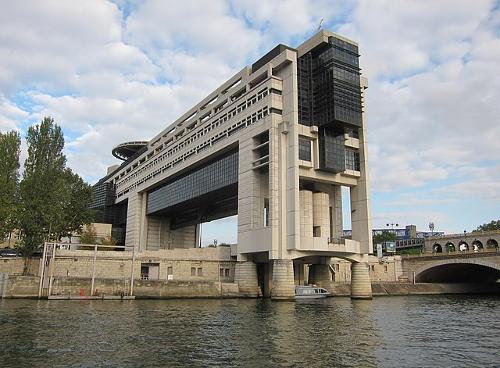 Ministry of Economic Affairs FrancePhoto: Art Anderson CC 3.0 Unported no changes made
Ministry of Economic Affairs FrancePhoto: Art Anderson CC 3.0 Unported no changes madeAs of 1 January 2002, the coins and notes of the franc were replaced by euro coins and notes. Economic growth was 0.8% from 1990 to 1994. In 1998 it had risen to 3%, while inflation fell below 1%. Inflation rose again in 2000 and 2001 to 1.7 and 1.6 respectively. In 2000 GDP grew by 3.2%. Unemployment fell in that year from 10.6% in 1999 to 9.7% in 2000.
The gross domestic product in France in 2001 was 1,460 billion euros. Total growth for 2001 was 2%. The French economy was thus one of the fastest growing of the group of seven largest economies in the world.
Recent figures (2017) on the economy of France are:
GNP: 2.6 billion dollars (tenth economy of the world)
GDP Per Capita: $ 44,100
Economic Growth: 2.3%
France had a labor force of 30.7 million people in 2017, of which a growing number of women. The distribution of the labor force over the different economic sectors (2017) is: agriculture: 1.8%; industry: 20% and services sector: 77.2%.
The Ile-de-France region is by far the richest region in France; 22% of the national income is earned in this region. In general, the north of France is more densely populated and mainly focused on industry, while the south is more focused on tourism and agriculture. A second dividing line is that between east and west, with the east being more prosperous than the west.
Agriculture, livestock, forestry and fishing
General
France has the largest agricultural sector in the European Union. Nevertheless, the relative importance of this sector has fallen sharply since World War II compared to the rest of Western Europe. In 2013, for example, only 1.5 million people were active in agriculture, forestry and fishing. In 1970 there were still 2.8 million.
Productivity has increased in the same period and France is still the second largest exporter of agricultural products in the world after the United States. In 2000, France exported almost 40 billion euros worth of agricultural products. In the same year, France imported almost 30 billion euros.
40% of the agricultural companies specialize in intensive and extensive livestock farming, 20% in arable farming and 12% in viticulture.
Agriculture
About half of the agricultural land in France is used to grow grain. The grain yield is about 17% of the total agricultural yield, but grapes, vegetables, fruits and other important crops take up less agricultural land and yield much more.
France has approximately 30 million hectares of agricultural land, of which approximately 18 million hectares is cultivated land, making it the largest agricultural area in the European Union. Of this gigantic acreage, 58% is arable land, over 37% is permanent grassland and almost 5% is covered with permanent crops such as fruit, olives and vineyards. Cultivation improvement, expansion of the company size (e.g. through reallotment and cooperatives) and mechanization make an important contribution to the production increase per ha.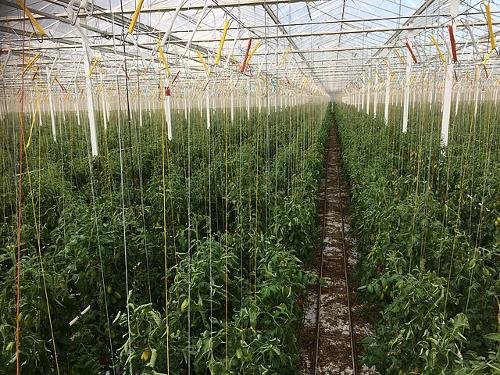 Growing tomatoes in green houses, FrancePhoto: Mouh2jijel CC 3.0 Unported no changes made
Growing tomatoes in green houses, FrancePhoto: Mouh2jijel CC 3.0 Unported no changes made
In order to be able to produce more profitably, efforts are being made to further increase the average farm size (approx. 30 ha in 1988) by, among other things, buying out small companies. In 1999 the sector had approximately 680,000 companies. The increasing increase in scale is also important, as a result of which the average farm size increased from 23.4 hectares in 1979 to 41.7 hectares in 1997.
The main agricultural lands are on the loam plateaus of the Paris Basin and in the north, where wheat, sugar beets, rapeseed and flax are grown, among other things. Alsace, the large river valleys and the irrigated zones of the south are also rich agricultural areas. Hops are mainly grown in Alsace and French Flanders. Oats and barley are cultivated more widely. Maize is grown in Languedoc and Aquitaine, while rice is still grown in the Camargue.
Horticulture and vineyards are mainly found in the valleys of rivers such as the Loire, the Garonne, the Rhône and along the Mediterranean coast. In addition, there are large horticultural areas around Paris, in the coastal regions of Brittany, Alsace and French Flanders. French viticulture includes many high-quality wines. France occupies an important place in the world ranking of producers of wheat, barley, sugar and wine.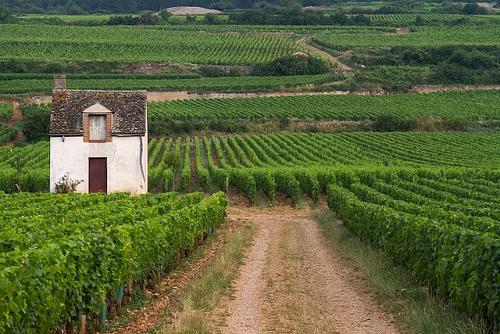 Vineyard in Volnay, FrancePhoto: Mark Gorzynski CC 4.0 International no changes made
Vineyard in Volnay, FrancePhoto: Mark Gorzynski CC 4.0 International no changes made
Livestock farming
France is the largest meat and dairy producer in Europe and livestock farms are spread all over the country. Important cattle regions are mainly found in the fringes of the Massif Central and in the Atlantic zone: Normandy, Brittany, Picardy and French Flanders.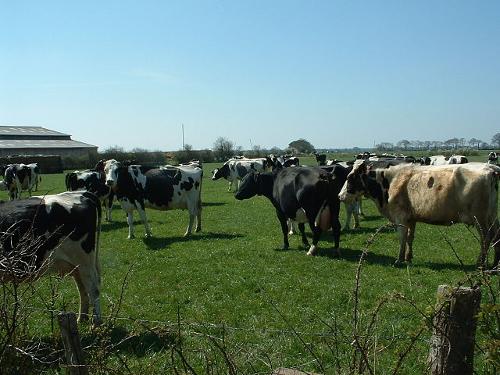 Cattle Chauvé, FrancePhoto: Mark Gorzynski CC 4.0 International no changes made
Cattle Chauvé, FrancePhoto: Mark Gorzynski CC 4.0 International no changes made
Sheep farming, especially in the Massif Central and the Pyrenees, is important for mutton and cheese. In general, there is also a strong tendency in livestock farming towards the mechanization and expansion of agricultural cooperatives and reallotment.
Forestry
The forest area is gradually increasing again due to afforestation of disused wastelands, abandoned fields and mountain areas. At present, just over a quarter of the total land area is covered by forests. The majority of the forests consists of deciduous trees, but conifers are rapidly expanding due to the higher yield.
Only the state's forested land is exploited. Two thirds of the forest land belongs to private individuals and is too scattered to be exploited successfully. About 550,000 people work in the forestry and timber industry.
Fishing
Fishing is not an important sector for the French economy. And that is remarkable given the extensive coast, but the fishing quotas imposed by the European Union are preventing an expansion. It is therefore not surprising that only 0.1% of the working population works in the fishing sector.
The main branch of the fishery is coastal fishing. French fish production takes place mainly in Brittany, where more than half of the total production is realized. Some important ports are Boulogne, Concarneau, Le Havre, La Rochelle and Sète. Oyster farms are a sector that is developing well.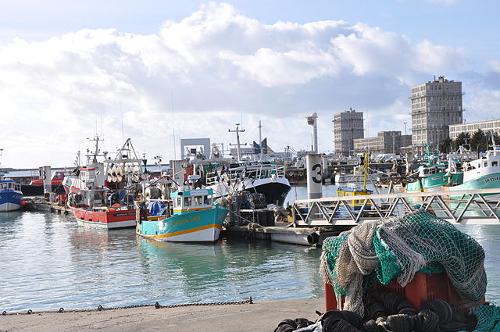 Fishing boats in the port of Le Havre, FrancePhoto: Philippe Alès CC 4.0 International no changes made
Fishing boats in the port of Le Havre, FrancePhoto: Philippe Alès CC 4.0 International no changes made
Mining and energy supply
Mining
The nationalized and highly modernized coal mines are mainly found in the Lorraine Basin and the somewhat smaller basins in southern and central France, the Basin of the North and Pas de Calais. Decreased yields and increasing use of nuclear energy caused production to be phased out gradually, e.g. from 22 million tons in 1976 to 9 million tons in 1995. It is already the case that about 15 million tons of coal have to be imported annually.
Not so long ago, France was one of the most important iron producers in Europe. However, iron production has fallen dramatically in recent decades. This was due to a shortage of markets and many competing countries. Important mining products are still aluminum ore, potassium salt and rock salt. Much less important raw materials are zinc ore, gravel, lead ore and uranium ore.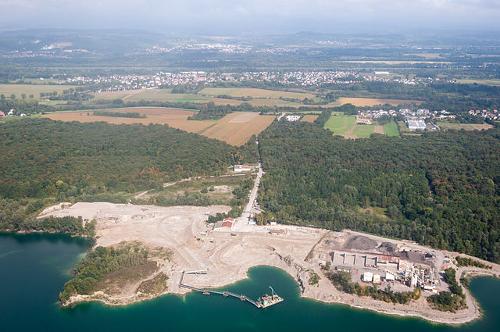 Gravel mine in Saint-Louis, Alsace, FrancePhoto: Hansueli Krapf CC 3.0 Unported no changes made
Gravel mine in Saint-Louis, Alsace, FrancePhoto: Hansueli Krapf CC 3.0 Unported no changes made
Most of the (small) petroleum production comes from the fields of Parentis-en-Born in Les Landes and from the Paris Basin. Natural gas production in Lacq is stagnating after years of strong increase. A decrease is foreseen if no new gas bubbles are detected in the short term.
Energy supply
Electricity production has risen sharply in France, for example by 110% between 1980 and 2000. Only 10% of the electrical energy comes from thermal power stations, about 20% from hydroelectric power stations and over 70% from nuclear power stations.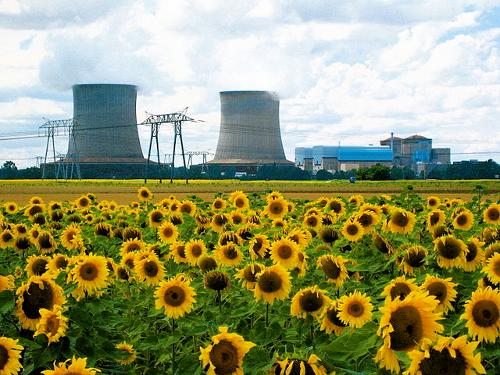 Nuclear powerplant, Saint-Laurent-des-Eaux, FrancePhoto: Nitot CC 3.0 Unported no changes made
Nuclear powerplant, Saint-Laurent-des-Eaux, FrancePhoto: Nitot CC 3.0 Unported no changes made
For the supply of petroleum, France is heavily dependent on the Middle East, for natural gas from Norway, Algeria, the Netherlands and Russia, for coal from Germany, Poland and South Africa. The use of gas in France is less than half of that in Germany or the United Kingdom, mainly due to the high production of nuclear energy.
In order to be able to provide for its energy needs as independently as possible in the future, France has made the development of nuclear energy a spearhead of policy and the use of nuclear energy has increased rapidly due to an accelerated energy program. During the eighties of the last century, France surpassed Japan and the then Soviet Union to become the second largest producer of nuclear energy.
Industry
Industrial production doubled in the 1960s, but from the 1970s onwards this sector suffered from the global crisis.
Nevertheless, industrial production increased, partly due to the strongly propagated increase in scale. The main industrial areas are to the east of the Le Havre – Marseille line. The Paris city region is a major center of the manufacturing industry (cars, electrical and electronic equipment, pharmaceutical and photographic products). In addition to research laboratories, haute couture, articles de Paris (jewelery, perfumes) and publishing houses, food and metal processing and the furniture industry are also particularly well represented. The industrial areas of the north and north-east (Alsace-Lorraine) are the most important centers of heavy metallurgy and of the chemical industry, and the textile industry is also important.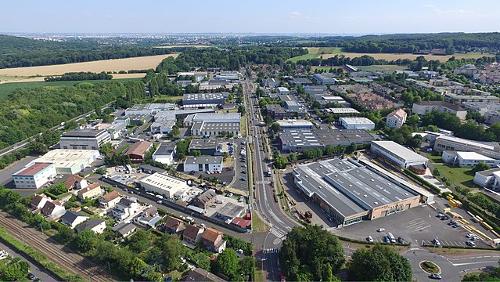 Industrial zone at Domont, north of ParisPhoto: Ville de Domont CC 4.0 International no changes made
Industrial zone at Domont, north of ParisPhoto: Ville de Domont CC 4.0 International no changes made
The third major industrial area is around Lyon and includes the Rhône and the Alps. The old textile area around Lyon and the old coal and metallurgy cores of St-Étienne and Le Creusot are undergoing a new development thanks to the expansion of the metal construction and (organic) chemical industry and especially the cheap hydropower energy, which formed the basis for the establishment in the Alps from modern electrochemical and electro-metallurgical companies.
Less important industrial zones are those on the Mediterranean coast, where salt pans, bauxite mines and the old fat-processing industry form the basis for a modern chemical and aluminum industry. Furthermore, there is metal construction, shipbuilding and fertilizer production. Southwest Aquitaine is a growing industrial area thanks to the electrochemical and metallurgical companies in the Pyrenees, the chemical companies of Lacq and the aerospace industry in Toulouse. In Brittany, in addition to the old food industry and shipbuilding, the car industry and electronic construction have also expanded significantly.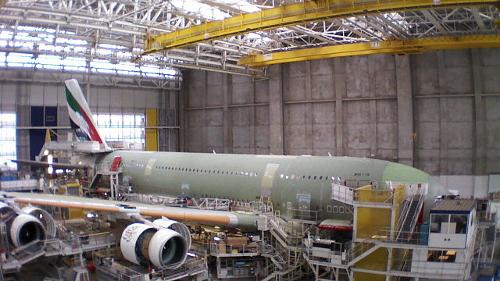 Aircraft industry is important for Toulouse, FrancePhoto: Nicolas Halftermeyer CC 4.0 International no changes made
Aircraft industry is important for Toulouse, FrancePhoto: Nicolas Halftermeyer CC 4.0 International no changes made
France has many textile areas. The north is the main center for wool and flax fabrics and for cotton production. The Vosges (Mulhouse) and the Lower Seine region (Rouen) specialize mainly in cotton and Lyon is the major production area for synthetic and artificial fiber processing. In the Languedoc, Mazamet is a specialized producer of woolen fabrics. Incidentally, the textile industry continued to decline in the 1970s.
In addition to Paris and the north, ready-to-wear is spread over all major centers and is an important export product. The highly diversified metal construction mainly includes car production, shipbuilding (St-Nazaire, Bordeaux, Le Havre, Dunkirk, Marseille area), aircraft construction (Paris, Toulouse, Nice), electrical equipment, including Compagnie Générale d'Électricité (in Paris [ 60%], Lyon, Grenoble). Le Creusot is the center of the important arms industry. Food industry is widely spread; apart from the canning factories of Brittany and the biscuit factories of Nantes, Paris is the most important center.
Biotechnology
The French biotechnology market is the third in Europe, after Great Britain and Germany. Medical biotechnology is the most important branch of this sector. The perspectives in agricultural biotechnology are somewhat less, there are fears of being swamped by cheap American genetically modified products. Environmental technology is only a relatively small part of biotechnology. Technopoles are French "brain parks", often located at universities or other research institutions, and are mainly focused on pharmacy.
The main regions where biotechnology is present are:
Ile de France, with computer science, surgical equipment and genetic research.
Rhône-Alpes, with medicines, veterinary products and vaccines.
Alsace, which is home to a collaboration of French, German and Swiss researchers called BioValley.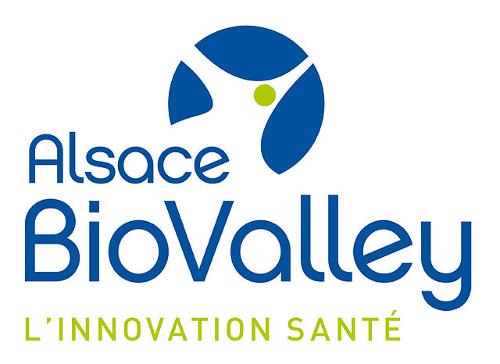 Logo BioValley, Alsace, FrancePhoto: Alsace BioValley CC 4.0 International no changes made
Logo BioValley, Alsace, FrancePhoto: Alsace BioValley CC 4.0 International no changes made
Nord / Pas de Calais, with mainly blood tests around the CHRU in Lille, the largest teaching hospital in Europe.
Toulouse and Montpellier, with a lot of agricultural research.
ICT-sector
The total ICT sector can be divided into three sub-sectors: IT, telecommunications and electronics. Until 2000, the ICT sector in France grew by no less than 10% per year and in 1999 had a turnover of 148 billion euros and had more than 710,000 employees. The ICT sector is now very important to France.
Medical sector
The sector can be divided into two subsectors: X-ray equipment and medical surgical equipment. The X-ray equipment subsector is highly concentrated and the largest company accounts for 80% of the industry's turnover. Most companies in the medical-surgical sector are small and medium-sized enterprises.
Construction and infrastructure
The construction sector still has a lot of turnover in France, new homes and business premises are being built. The growth of the infrastructure is mainly realized by the local authorities and private clients. In addition, "Energie de France" and "Gaz de France" invested a lot in their infrastructure.
Machine industry
The French market for machines and tools amounted to 1.9 billion euros in 2000 and ranks seventh worldwide with 4% of the market. Within Europe, France ranks third after Germany and Italy with 10% of the market. In total, 6,500 people are employed by about 100 machine manufacturers.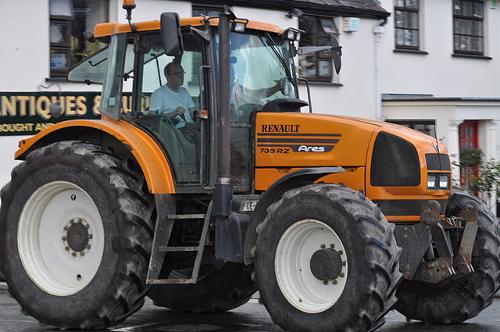 Renault, producer of agricultural machines in FrancePhoto: Peter Mooney CC 2.0 Generic no changes made
Renault, producer of agricultural machines in FrancePhoto: Peter Mooney CC 2.0 Generic no changes made
The turnover of agricultural machinery is the largest in Europe at 3.8 billion euros. This sector has a trade deficit of more than 1 billion euros, which is caused by the large-scale import of harvesting and lawn mowers.
Chemistry and plastics
The turnover of the chemical industry in France in 2001 amounted to 85 billion euros, making this sector the second largest in the country after the automotive sector. On a world level with France with approx. 5% of global production in fourth place, after the United States, Japan and Germany. In total there are approximately 240,000 people working in the chemical sector in more than 2,100 companies. Chemical factory Solvay in Tavaux, Jura, Franche-Comté, FrancePhoto: Pline CC 3.0 Unported no changes made
Chemical factory Solvay in Tavaux, Jura, Franche-Comté, FrancePhoto: Pline CC 3.0 Unported no changes made
Chemical market size per sub-sector (2000):
Medicines 31%
Organic chemistry 25%
Parachemia 17%
Soap, perfume, etc. 16%
Inorganic chemistry 8%
Pharmaceutical basic products 3%
Metal (machining) industry
The French steel industry mainly produces semi-finished products. The number of jobs in this sector has fallen sharply in recent decades from 139,000 in 1980 to 40,000 in 2013.
France ranks eleventh worldwide. In Europe, France comes third after Germany and Italy. The Member States of the EU are the most important trading partners with 92% of imports mainly from Belgium and Germany and 83% of exports mainly to Italy, Germany and Spain.
Transport equipment industry
Production is mainly attributable to PSA Peugeot Citroën with 57.5% and Renault with 41.4%. The French automotive industry employs approximately 320,000 people, including a third in the supply industry.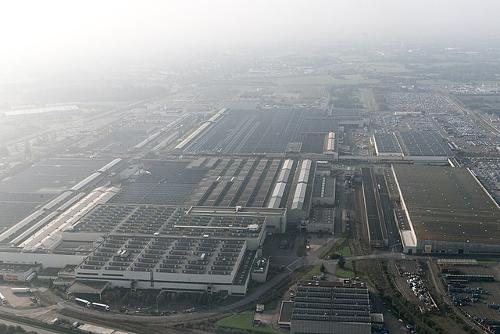 Pegeot factory in Rennes, FrancePhoto: Pymouss CC 4.0 International no changes made
Pegeot factory in Rennes, FrancePhoto: Pymouss CC 4.0 International no changes made
Three quarters of the turnover of the French aviation industry is generated from civil aviation and a quarter from defense. Most orders come from Europe, the United States, Canada and the Middle East.
The turnover of the railway industry is growing strongly, mainly due to the increase in exports.
Packaging industry
The packaging industry is a major sector in France. The food industry is the most important consumer of packaging and also the cosmetics and health industry. The main regions for the packaging industry are Rhône-Alpes, Ile-de-France, Haute-Normandy and Picardy. Almost 30,000 people are employed in this sector. The main trading partners are Germany, Italy, Belgium, Spain and Great Britain.
Food, beverages and tobacco industry
The products of the food industry are mainly sold on the domestic market, making this sector less prone to economic downturns. There is a large export surplus of wine, dairy products, champagne and sparkling wines. France mainly imports canned goods, meat products, oils and fats. This sector employs more than 500,000 people, with which the sector provides almost 15% of the jobs of the total industrial sector.
Trade
France is the second largest exporter in Western Europe after Germany and is currently (2017) 6th in the world ranking. Trade relations are mainly maintained with the other EC countries and otherwise with associated states. The main trading partners are Germany, Belgium and Luxembourg, Italy, the Netherlands, Spain and the United States. About one-sixth of foreign trade takes place with Germany. Since 1999, Spain has been France's third largest export market after Germany and Great Britain. Outside Europe, the United States is the main trading partner. Exports to East Asia amount to only a few percent of the total.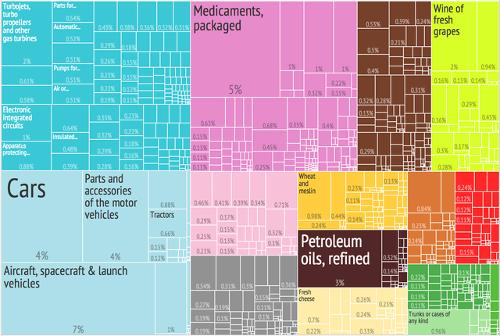 Export products FrancePhoto: Rom1sub, CC 3.0 Unported no changes made
Export products FrancePhoto: Rom1sub, CC 3.0 Unported no changes made
In 2017, imports totaled $ 602 billion. Total exports from France were $ 550 billion in 2017. The export consists mainly of agricultural products such as wine, grain, butter and cheese, as well as semi-finished products, machines, equipment and cars. However, the auto industry faces strong competition from the Japanese auto industry. Important import goods are raw materials and energy sources, semi-finished products, industrial goods and agricultural products (especially tropical products, cotton and wool).
Traffic
France has a well-developed traffic network, radially oriented towards Paris in terms of railways and roads.
The road network covers 964,000 km, of which approximately 8,600 km is a motorway (with mostly tolls) and 29,000 km of main and national roads. The French government has drawn up a "master plan" to extend the motorways by an additional 5,000 km. They also want more Trans-Pyrenean tunnels for a better connection with Spain. 60% of goods transport is by road.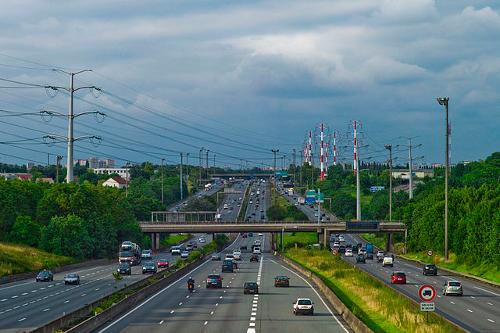 A6, part of the Route du Soleil, FrancePhoto: Alexandre Vialle CC 2.0 Generic no changes made
A6, part of the Route du Soleil, FrancePhoto: Alexandre Vialle CC 2.0 Generic no changes made
The railway network comprises approximately 35,000 km of track (80% electrified). Important is the special TGV network or high-speed line. The super-fast TGV train (Train à Grande Vitesse) has been running since 1981, bringing cities such as Lyon, Bordeaux and Nice, but also Brussels and Amsterdam, a short distance from Paris. Expansions are foreseen via Strasbourg to Germany and to Spain and Italy.
Construction of the Channel Tunnel, which connects France to England, started in 1987. The Channel Tunnel, which runs between Calais in France and Folkestone in Britain, was designed by French and British engineers and opened in 1994. It is a 50 kilometer long railway tunnel that runs under the Pas de Calais. The crossing between the two countries now takes only 35 minutes. The Paris-London journey takes 2.30 hours, Brussels-London 2.40 hours.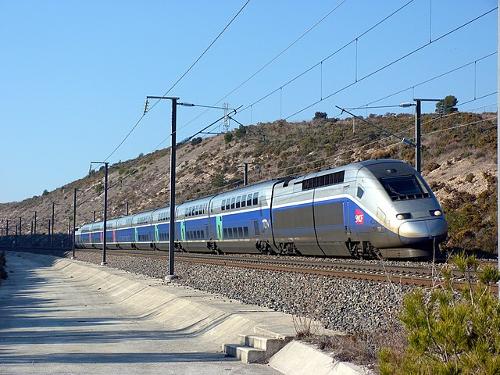 Train Grande Vitesse (TGV), high speeds train in FrancePhoto: Alaric Favie, CC 3.0 Unported, no changes made
Train Grande Vitesse (TGV), high speeds train in FrancePhoto: Alaric Favie, CC 3.0 Unported, no changes made
Inland navigation has a network of 8600 km of waterways. However, most of this network is only suitable for smaller vessels and is practically out of use. Inland shipping therefore only accounts for 4% of the goods transport. However, heavy traffic and transport have the Seine, the canalised Rhine and Moselle, most of the canals in Northeast France and the Rhône-Rhine Canal, which was built in 1988 and connects Rotterdam with the Mediterranean.
Several new waterways are under construction, including Seine – North-East, which will connect Paris with Lille and the Moselle, and the Mediterranean – Rhine, which has a high priority. The main inland ports are Paris, Rouen and Strasbourg.
The merchant fleet is largely state-owned and of the many seaports, Le Havre, Dunkirk and Nantes-St.-Nazaire are the most important. However, Marseille is the most important port for France or the Mediterranean and is the third port in Europe.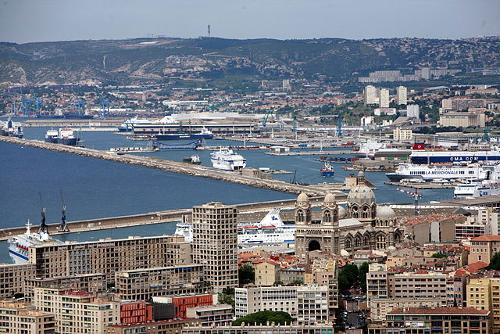 Harbour of Marseille, FrancePhoto: Rama CC 2.0 France no changes made
Harbour of Marseille, FrancePhoto: Rama CC 2.0 France no changes made
Air France is the largest airline. UTA focuses most of its flights on Africa and Air Inter handles domestic air traffic. The main airports are: Charles de Gaulle, Orly and Le Bourget (closed to international traffic) near Paris and Nice airports as the third international airport, Lyon and Marseille.
Regional airports are increasingly used for international flights; East of Paris is a special airport for air traffic, Europort. Plans are to open a third airport in the Paris region in 2020: Chaulnes-Vermandovilliers, 130 kilometers north of Paris in the Somme department.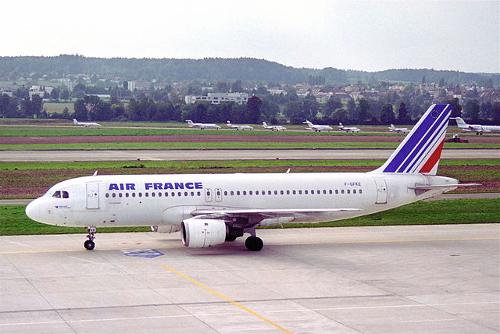 Airbus 320-111 from Air FrancePhoto: Aero Icarus CC 2.0 Generic no changes made
Airbus 320-111 from Air FrancePhoto: Aero Icarus CC 2.0 Generic no changes made
Sources
Bailey, R. / Frankrijk
Kosmos-Z&K
France
Lonely Planet
Frankrijk
Van Reemst
CIA - World Factbook
BBC - Country Profiles
Last updated June 2025Copyright: Team The World of Info